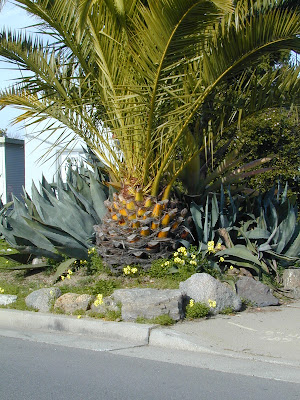Palms do not develop secondary wood, they don't get wider as they age. All the width of a palm is developed at the ground level by adding new tissue to existing tissues. As you may know these seem to take forever to "off the ground" but once they do they actually grow pretty fast. This one has been here awhile. You can see the base of the palm is already as wide as it will get. Does this make sense? Very different than a maple tree.
The canary island palm is a large, slow growing when young, single stemmed palm, up to 60' with a large round head maybe 20-30' wide with over 100 leaves. Trunk about 2-3' wide.
Leaves are pinnate shaped, 10-20' long arched up and out, dark green leaflets, stiff. The ones closest to the trunk are spine like and very sharp, not a great plant around kids.
Flowers are borne in the foliage, near the bottom on a large 2-6' stalk, male and females on different plants. Fruit on the females only, a large yellow/orange fleshy drupe.
The trunks are smooth, well, not like a queen palm but not like others that leave the base of the petiole attached, but they do leave scars where the leaves were attached. The common management technique is to cut them off making for a smooth trunk. The pruning usually goes too high and you end up with something resembling a pineapple. When the leaves fall on their own they leave behind a diamond shaped scar.
Leaf bases not yet ready to fall off, someone pruned them to keep the fronds from falling on someone or something. This is the pineapple.
Plants are known to be susceptible to a disease called lethal yellowing, caused by a phytoplasma, a bacteria that only lives in the phloem of plants and transmitted by leafhoppers. One of the palms at RDM beach was diagnosed as such and died and was removed and replaced with a Wind Palm.
Misidentification. Not sure, look at the leaves, large pinnate type, large thick trunk, rough but without leaf bases attached, staying short and very broadly non-pedestrian friendly for a long time.
Way denser head (more leaves) and darker green than P. dactylifera, the date palm of which there are not a lot around (go out San Juan Rd near about 1480 and on the left side you will see one).
Location:






